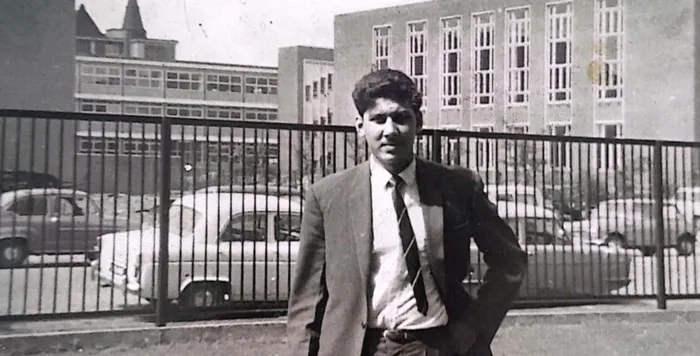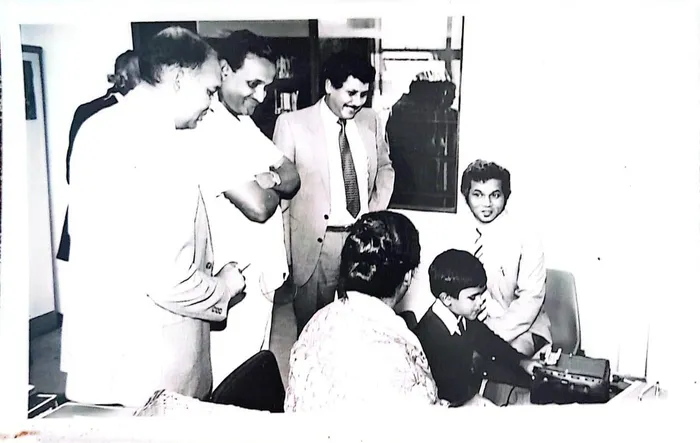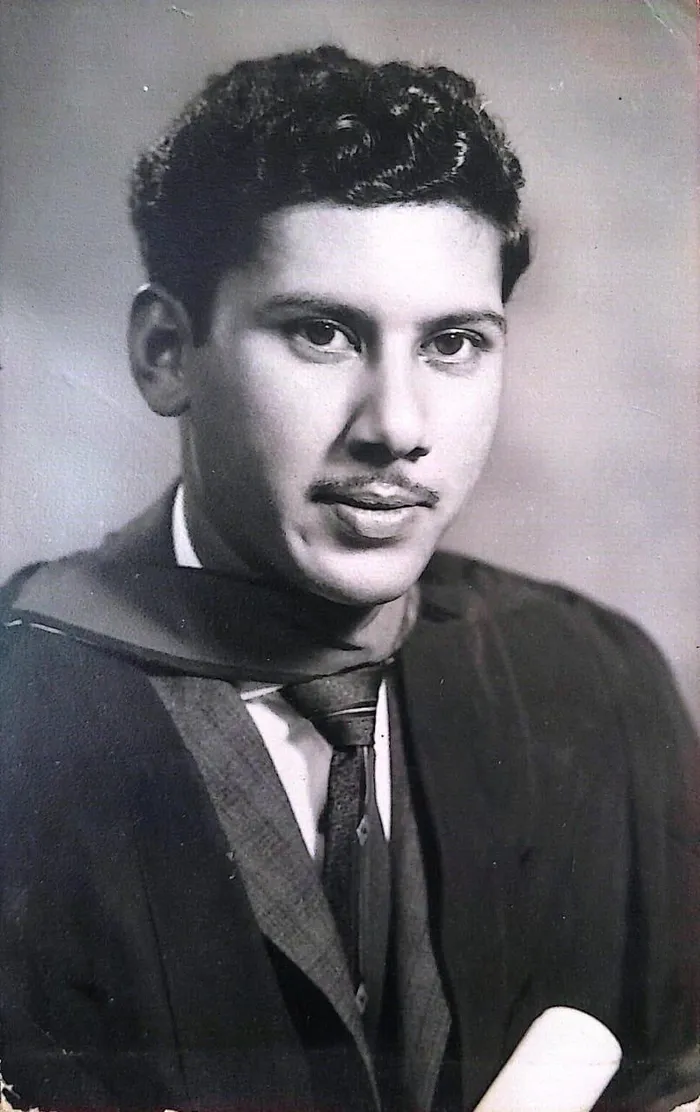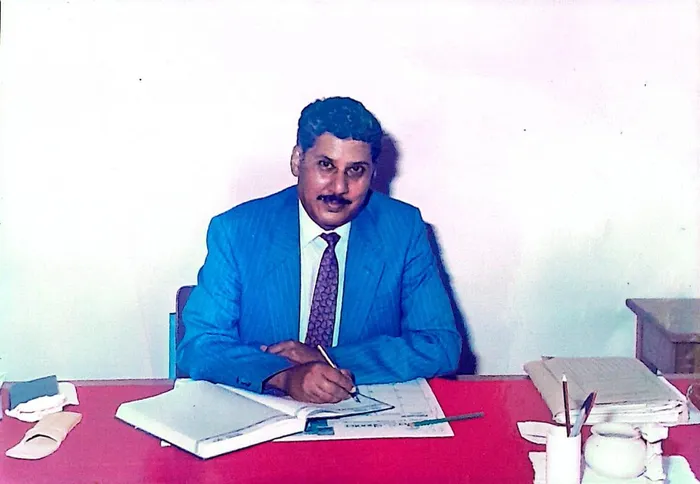A life committed to upliftment
PB Singh's lasting legacy

PB Singh at the University of Manchester in 1963.
Image: Supplied
IN CONTEMPORARY society, there are many trailblazers that have quietly chosen the challenge of charting new courses for the upliftment of the lesser endowed. In education the plight of special needs pupils was largely ignored and indeed othered.
Speaking at the opening of the iconic Sastri College, India’s first Agent General to South Africa, Sir Srinivasa Sastri, said: “What the Indian learner lacks in facilities, he more than makes up for in faculties.”
This famous anecdote was stated at a time when the community rallied together to erect their own schools as the State had no interest in providing education for its black population.
Moreover, special needs pupils were completely blindsided and it was the vision of Prithipal Bhoop Singh to bring it into focus. Singh passed away at the age of 86 on October 23, 2025.

PB Singh, third from left in a tie, with colleagues instructing a pupil on the braile machine.
Image: Supplied
“P.B. Singh”, as he was most often called, is a pioneer in the provision of special education and services for people with disabilities, and whose yeoman efforts in the arena have improved the lives of thousands of South Africans.
Singh’s involvement with learners with special education needs began in 1962 shortly after completing his teaching degrees (B.A., B.Ed., U.E.D) at the University of Natal. He was encouraged by a benevolent mentor and professor to read for a certificate in remedial education at the University of Natal.
Having passed with distinction he then volunteered his services at the Merick Bennet Clinic, which was situated at the Medical School in Umbilo. It was here that his interest in the education and care of pupils with special education needs was sparked.
He soon realised that there were thousands of children who had learning difficulties, the visually and hearing impaired, the physically and intellectually disabled were denied education.

After his graduation ceremony from the Natal University in 1962.
Image: Supplied
In subsequent years, Singh worked tirelessly at the community level with other like-minded colleagues and parents to establish education and rehabilitation services for such children and adults as none existed at that time for the Indian community.
In 1963, he was selected by the Natal Indian Blind Society to train at the University of Manchester as a teacher of the deaf. He completed this in September 1965 and became the first qualified Indian teacher of the hearing impaired. On his return, he spent most of his afternoons at the offices of the Natal Indian Blind Society selecting pupils for the proposed school for the hearing impaired. He conducted audiometric and speech tests and prepared pupils for admission.
In 1967, he joined the staff of Arthur Blaxall School in Lorne Street and this afforded him more time in planning a new school for the hearing impaired.
In 1968, he was transferred to Cavendish Primary School to start the first “special class” for Indian pupils. He designed and developed both the timetable and curriculum, which formed the basis of future classes and teacher training programmes.

At his desk at the Department of Education.
Image: Supplied
In 1969, he was seconded to psychological services and was given the task of establishing special classes. In the absence of any teacher training programmes, he not only trained but also supervised the work of these teachers and established more than 80 of these classes. After this success, he was requested to plan and implement a system of remedial education. He had no structure to fall back on, but once again he planned and implemented his own system which he termed the “withdrawal system”, whereby pupils were withdrawn and given individual tuition in reading and mathematics. It proved to be a tremendous success and many pupils matriculated with flying colours.
In 1970, he was appointed as a senior assistant in psychological services and severed ties with the Natal Indian Blind Society where he was going to be the principal of the newly-established school for the hearing and visually impaired. He chose rather to work within the Department of Indian Education, where he could be more influential and achieve greater good.
In 1975, he was appointed as acting head of psychological services and special education. One of the highlights of his tenure was his presentation of a futuristic structure for psychological services and special education for Indian pupils.
After studying the Education Act and with the help of his mentor AK Singh, a planner in the Department of Indian Education, they campaigned the Department of Education that the department was responsible for the “education and training” of all pupils, including those with special needs and this led to the creation and subsidisation of all special schools. This resulted in the '70s and '80s being a period of rapid growth in the establishment of special schools.
They were the pioneers of many schools and not only conceived the idea and gave birth to these schools, but also displayed foresight, determination and perseverance. The Singhs made personal sacrifices in time, money and effort to establish, maintain and administer special schools in the different stages of their development.
Schools that benefitted from their foresight and involvement included:
- Golden Gateway School
- West Park School
- S Dass School
- Golden Steps School
- HS Ebrahim Training Centre
- Jiswa School
- Laudium Training Centre (Sunrise School)
- Actonville Training Centre
- Schola Amoris
- Stanger Training Centre
- Demorosa Prevocational School
- MC Kharbai School for the Deaf
- Arthur Blaxall School for the Visually Impaired
- Durban School for the Hearing Impaired
- AM Moolla Spes Nova
- RP Moodley School
In 1983, he was appointed head of psychological, guidance and special education, a post which he held until his retirement in 1996. In addition to being actively involved in these schools, he established services for gifted pupils and two pre-vocational schools for senior pupils from special classes. He devised a futuristic vision for psychological services and implemented it. It was unique and therefore became the foremost structure in the country.
After his retirement from the Department of Education, he continued his work to improve and uplift those with disabilities. In 1999, he was appointed president of the Association of Persons with Disabilities (APD) and served in the volunteer role up until August 2025. As president, he implemented many strategies to improve the quality of lives of persons with disabilities.
He initiated stimulation units in both urban and rural areas for non-school-going children with disabilities and introduced home-based care and support for parents and children with disabilities. He increased the number of protective workshops for adult persons with disabilities to eight facilities. While serving as president of APD, he continued to be involved with other organisations and schools and soldiered on to lend them support and advice until his death.
He served on the management council for the National Council for the Blind and the South African National Council for the Deaf. He also served on the management councils of the National Council for Persons with Physical Disabilities in South Africa.
He authored many articles on remedial and special education and the education of the hearing impaired.
His lasting legacy is not just recorded in policy and institutions, but in the thousands of lives he fundamentally changed. He gave the hearing impaired a way to connect, the blind a way to navigate, and the physically and intellectually disabled a pathway to independence.
Singh was truly a selfless and unassuming giant in his field. His contribution to the provision and advancement of special education is immeasurable and is borne testament in the many lives he helped improve.
- Golden Gateway School
- West Park School
- S Dass School
- Golden Steps School
- HS Ebrahim Training Centre
- Jiswa School
- Laudium Training Centre (Sunrise School)
- Actonville Training Centre
- Schola Amoris
- Stanger Training Centre
- Demorosa Prevocational School
- MC Kharbai School for the Deaf
- Arthur Blaxall School for the Visually Impaired
- Durban School for the Hearing Impaired
- AM Moolla Spes Nova
- RP Moodley School
In 1983, he was appointed head of psychological, guidance and special education, a post which he held until his retirement in 1996. In addition to being actively involved in these schools, he established services for gifted pupils and two pre-vocational schools for senior pupils from special classes. He devised a futuristic vision for psychological services and implemented it. It was unique and therefore became the foremost structure in the country.
After his retirement from the Department of Education, he continued his work to improve and uplift those with disabilities. In 1999, he was appointed president of the Association of Persons with Disabilities (APD) and served in the volunteer role up until August 2025. As president, he implemented many strategies to improve the quality of lives of persons with disabilities.
He initiated stimulation units in both urban and rural areas for non-school-going children with disabilities and introduced home-based care and support for parents and children with disabilities. He increased the number of protective workshops for adult persons with disabilities to eight facilities. While serving as president of APD, he continued to be involved with other organisations and schools and soldiered on to lend them support and advice until his death.
He served on the management council for the National Council for the Blind and the South African National Council for the Deaf. He also served on the management councils of the National Council for Persons with Physical Disabilities in South Africa.
He authored many articles on remedial and special education and the education of the hearing impaired.
His lasting legacy is not just recorded in policy and institutions, but in the thousands of lives he fundamentally changed. He gave the hearing impaired a way to connect, the blind a way to navigate, and the physically and intellectually disabled a pathway to independence.
Singh was truly a selfless and unassuming giant in his field. His contribution to the provision and advancement of special education is immeasurable and is borne testament in the many lives he helped improve.
Nirode Bramdaw is a Director of the 1860 Heritage Centre.